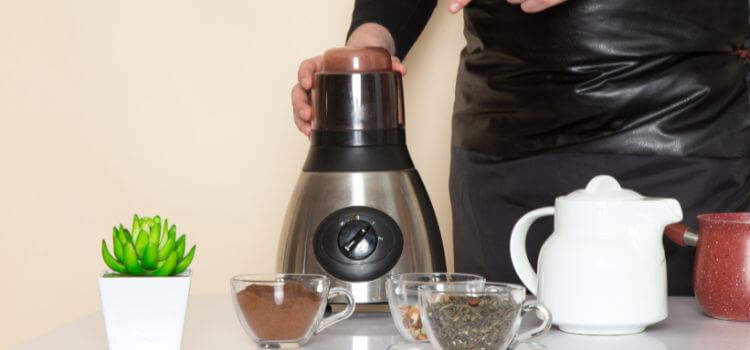
Introduction
When it comes to making your favorite coffee, the process of grinding the beans plays the most critical role in determining the flavor and aroma of your cup. Two common appliances often used for this purpose are coffee grinders and blenders. This article explores the differences between Coffee Grinder vs Blender. It helps you decide which is best suited for your daily grind.
The Purpose of Grinding
Before we dive into the specifics of coffee grinders and blenders, let’s understand the purpose of grinding coffee beans. Grinding coffee is essential to expose the flavors and oils locked within the beans. This process increases the surface area, allowing hot water to extract the coffee’s delightful flavors during brewing.

The Coffee Grinder
Burr Grinder
A burr grinder is popular among coffee enthusiasts for its consistent grind size. It crushes coffee beans between two burrs, resulting in uniform particles. This grinder offers greater control over the grind size, making it suitable for various brewing methods such as espresso, pour-over, or French press.
Blade Grinder
On the other hand, a blade grinder uses spin blades to chop the coffee beans into smaller pieces. While it is more budget-friendly, the grind produced by a blade grinder is often uneven, leading to an inconsistent brew.

The Blender
Types of Blenders
Blenders are versatile kitchen appliances used for various purposes, including making smoothies, pureeing fruits, and blending ingredients. Some blenders also come with a specific setting for grinding coffee beans.
Grinding Coffee Beans
If you are using a blender to grind coffee beans is a cost-effective solution for those who already own one. However, blenders need more precision and control than coffee grinders, resulting in an uneven grind.
Comparison of Coffee Grinder vs. Blender
Consistency of Grind
Coffee grinders, primarily burr grinders, provide a consistent grind size, ensuring even extraction and better-tasting coffee. Blenders, due to their design, create a mixture of coarse and fine particles, affecting the flavor and aroma of the coffee.
Heat Generation
Coffee grinders generate less heat during the grinding process, preserving the delicate flavors of the coffee beans. Blenders, on the other hand, can produce more heat, potentially altering the taste of the coffee.
Grinding Capacity
Coffee grinders are explicitly designed for grinding coffee beans. They can handle larger quantities, making them ideal for daily coffee preparation. Blenders, although capable, may be less efficient when grinding large amounts of coffee.
Which One to Choose? Coffee Grinder vs Blender
When deciding between a coffee grinder and a blender, consider your brewing method, desired grind consistency, and frequency of use. If you value precision and enjoy experimenting with different brewing techniques, a coffee grinder, especially a burr grinder, is the way to go. However, it can be a makeshift alternative if you already have a blender and only occasionally grind the coffee.
Maintenance and Cleaning
Coffee grinders require regular cleaning to prevent the buildup of coffee oils and maintain the freshness of your coffee. On the other hand, blenders are relatively easy to clean. However, their blades may retain coffee residues, impacting the flavor of future blends.
Price Range and Accessibility
Blenders are generally more affordable and widely available compared to coffee grinders. A blender might be more practical if you are on a budget or prefer multipurpose kitchen appliances.
The Perfect Grind for You
Ultimately, the perfect grind depends on your preferences and the type of coffee you enjoy. Experimenting with the different grind sizes and brewing techniques will help you discover the ideal cup that suits your taste buds.
Tips for Better Grinding
- Use fresh roast coffee beans for the best result.
- Adjust the grind size based on your brewing method.
- Grind coffee in small batches to maintain freshness.
- Clean your coffee grinder regularly to prevent stale coffee flavors.
Enhancing Coffee Flavor
For a more flavorful experience, explore different coffee origins and roasts. Each bean brings a unique set of flavors and aromas to your cup.
Brewing Techniques
Experiment with various brewing methods, such as pour-over, French press, espresso, or cold brew, to find the one that complements your preferred coffee profile.
Common Mistakes to Avoid
- Avoid using a blade grinder for fine espresso grind.
- Don’t leave coffee beans in the grinder for an extended period.
- Avoid grinding too delicate for a French press, as it may lead to over-extraction and bitterness.
Experiment and Enjoyment
Remember that coffee brewing is an art with no strict rules. Feel free to experiment with different grind sizes and brewing techniques to discover your perfect cup of coffee.
Final Words
Coffee grinders and blenders have pros and cons for grinding coffee beans. While coffee grinders, primarily burr grinders, offer superior grind consistency and control, blenders can be a viable option if you are on a budget or only occasionally grind coffee. Choosing between a coffee grinder and a blender depends on your brewing preferences and how much control you want over your coffee’s taste and aroma.
FAQ about Coffee Grinder vs Blender
You can always use a blender to grind coffee beans, and it may not provide the fine grind required for espresso. A dedicated coffee grinder, especially a burr grinder, is recommended for espresso brewing.
Yes, blade grinders are generally more affordable than burr grinders. However, keep in mind that blade grinders may produce inconsistent grind sizes.
Yes, some coffee grinders can be used to grind spices as well. However, it’s best to designate a separate grinder for coffee and spices to prevent flavor contamination.
It maintains the freshness of your coffee and prevents coffee oil buildup. It’s recommended to clean your coffee grinder at least once a week.
While you can grind flavored coffee beans in a coffee grinder, be aware that the flavor may linger in the grinder and affect the taste of future batches of coffee.
Leave a Reply